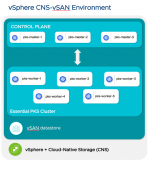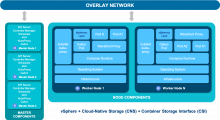by: VMware Lead Cloud Infrastructure Administrator Alfred Cheung; VMware Senior Director IT Chanh Chi; VMware Senior Site Reliability Engineer Jason Hutson; VMware Director, Cloud Infrastructure Kandy O’Mara; VMware Senior Site Reliability Engineer Telmo Rodrigues; VMware Staff Engineer – 2 Alex Romanenko; VMware IT Manager Manas Singh; VMware Director, Cloud Infrastructure Operations Zaigui Wang
VMware IT runs its $10B business using VMware products. By leveraging these solutions, we are able to optimize cloud-native application development/deployment. In this way, VMware will be better positioned to meet the various demands of our business.
A key aspect of this integration involves Cloud-Native Storage (CNS), a powerful technology that accelerates the adoption of cloud-native applications. To that end, VMware developed VMware vSphere®-CNS 1.0 running on top of any block storage solution including VMware vSAN™. CNS is accessed through the Cloud Storage Interface (CSI) and Cloud Configuration Manager (CCM) enabled at the vSphere layer.
Why CNS/CSI with vSAN?
- Dynamic volume provisioning for vSAN gives a capability to the Continuous Integration/Continuous Development (CI/CD) pipeline to create and mount volumes as needed by the application containers with persistent-volume requirements without any dependencies on the infrastructure admin/support teams. It also reduces the latency due to the integrated hyper-converged infrastructure (HCI).
- Dynamic provisioning enables defining the necessary kind of storage policies required by a specific application/service.
- VMware vCenter® admins now have reduced effort without losing visibility and control on dynamic provisioning. The actions are transparent to the vSphere infrastructure and can be integrated into its native monitoring and alerting systems such as Wavefront™ by VMware, VMware vRealize® Operations™ Manager (vROPs), and VMware vRealize® Log Insight™.
Our Kubernetes journey
We needed to strengthen our stateful application offerings as they are a vital part of our cloud-native integration. Containerization of MySQL is an example of this as it offers built-in high availability, where a container orchestration platform like Kubernetes manages the uptime of the service (MySQL in this case). It also brings in agility to the deployment of the service.
Deployment of MySQL with CNS on an Essential PKS platform forms a key cog in the wheel. All the advantages of containerization are brought to MySQL on vSAN, and it is storage agnostic from an end-user standpoint—a significant benefit in heterogeneous enterprise environments.
The use cases involved in this setup include:
- Essential PKS cluster with Calico providing the networking and network policy
- Bitnami’s Kubeapps—At the heart of Kubeapps is an in-cluster Kubernetes dashboard that provides a simple browse-and-click experience for installing and manage Kubernetes applications packaged as Helm Charts.
- The MySQL deployment via Kubeapps that currently uses a CNS-provided persistent volume claim
- Wavefront for monitoring vCenter-vSAN as well as Essential PKS cluster


Being the first customer
In all, vSphere-CNS 1.0 on the vSAN cluster has made VMware IT’s ongoing journey to a cloud-native ecosystem faster and more efficient. We also believe every solution should withstand the rigors of internal use—including being put to the test by globally dispersed end users.
Look for future blogs where we will go into detail regarding the tools employed to integrate CNS and other vital cloud-native software.
VMware on VMware blogs are written by IT subject matter experts sharing stories about our digital transformation using VMware products and services in a global production environment. Contact your sales rep or vmwonvmw@vmware.com to schedule a briefing on this topic. Visit the VMware on VMware microsite and follow us on Twitter.



